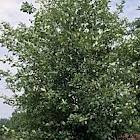The alder buckthorn is a relative of the common buckthorn and can be distinguished from it because of the narrower leaves of the former and the colour of its berries, which start red and then turn purple-black. The alder buckthorn’s leaves are similar to those of the alder, hence its name. It is a member of the Rhamnnaceae family as is the common buckthorn and ber fruit. In fact it is also known as Rhamnus frangula. This tree is widespread in the British Isles , although not all that common. It is native to Europe and parts of North Africa .
The tree grows to heights of 4 to 5 metres, and is a straggly tree, preferring to live in wet or damp woodland, moors and heaths and along the banks of rivers. It can be coppiced and trimmed so makes a good hedge. It flowers between May and June, with the berries ripening between September and November. These are toxic and the sap of the tree is a skin irritant. In Britain it is also known as Black Dogwood.
It has a milder laxative action than its relative, and can safely be used by children and pregnant women; although care must be taken as it should not be taken for long periods. Two weeks is the maximum period recommended for its use. Also the bark should not be used when fresh; rather it should be harvested in June, and can be stripped from branches and trunks in quills. The bark should be dried and stored for at least a year, so that it is free of the anthrones and anthranols which can cause vomiting.
 Its main traditional use has been of a mild laxative with a similar action to that of senna. It has been used at least since the Middle Ages for this purpose, so has been approved as safe for use by the German Commission E, although this safety ruling has been questioned.
Its main traditional use has been of a mild laxative with a similar action to that of senna. It has been used at least since the Middle Ages for this purpose, so has been approved as safe for use by the German Commission E, although this safety ruling has been questioned. The wood is bright yellow and was prized in the past for the production of gunpowder. The inner bark is a violent purgative but has been used to get rid of intestinal worms, and as a tonic, as well as for stomach bloating, hepatitis, cirrhosis, jaundice and liver and gall bladder problems. However such uses are not recommended unless it is used under the careful supervision of a medical practitioner. The fruit juice was also once used as a laxative.
Typically the bark is used as a decoction – one ounce of dried bark to two pints of water, boiled down to one pint, may be taken one tablespoonful at a time, three to four times a day. This may also be used externally for gum diseases, and on irritated skin. It was also employed to get rid of head lice.
A word of caution, if you have any other stomach problems (other than constipation) or abdominal pains, do not use alder buckthorn as the problems will be exacerbated.
The bark produces a yellow dye, and the berries blue and grey dyes of various shades. The wood makes good charcoal which was used by artists.

















